Have you ever thought about the tales that make up Timog Katagalugan’s rich culture? Stories have always been key in telling who we are and where we come from. The Kumintang Epic, in particular, shines bright in the Filipino culture. This breathtaking epic tells the story of the land like no other. Let’s journey into the world of the Kumintang Epic together.
Key Takeaways:
- Discover the historical and cultural significance of the Kumintang Epic in Timog Katagalugan.
- Uncover the fascinating origins of the epic, from the tale of Mabunga to the legacy of Pinga and Haring Nga.
- Explore the unique characteristics of the Kumintang Epic’s literature, including its language and poetic devices.
- Understand the profound influence of the Kumintang Epic on Filipino culture, blending myth and history.
- Analyze the themes, motifs, and symbolism that shape the narrative of the Kumintang Epic.
The Historical Significance of the Kumintang Epic
The Kumintang Epic is very important in Filipino history, especially in Timog Katagalugan. Passed down through many generations, it shows us key parts of the Filipino culture and history.
This epic depicts the challenges, victories, and values of Filipinos over time. It has inspired people and passed on knowledge for many lifetimes. The stories within it have greatly influenced the Filipino identity.
This epic is a mix of myth and history. It tells stories of brave heroes, mighty warriors, and strong rulers. These tales have become essential in the history of the Filipino people.
“Through the Kumintang Epic, the history and struggles of our ancestors are brought to life, providing us with a deeper understanding of our roots and the evolution of our society.”
The Kumintang Epic is like a guide to the Philippines’ past. It helps us understand key moments and people in Filipino history. This includes times before foreign rule, the Spanish era, and more.
Origins of the Kumintang Epic in Timog Katagalugan
The Kumintang Epic started in the region of Timog Katagalugan. It shares stories about powerful battles, strong love, and the life of the Filipino people. By exploring where this epic began, we see the deep layers of its stories and what they mean to the area.
Uncovering the Roots: The Tale of Mabunga
Mabunga is at the epic’s core, a brave warrior. He meets mythical creatures and strong foes, showing timeless values like courage and honor. Through Mabunga’s tale, we see the unbreakable spirit of the Filipino people.
Illustrious Clans: The Legacy of Pinga and Haring Nga
The epic is also about the Pinga and Haring Nga clans. These clans are famous for their amazing acts and loyalty. Their stories make the Kumintang Epic rich, with many different characters and influences.
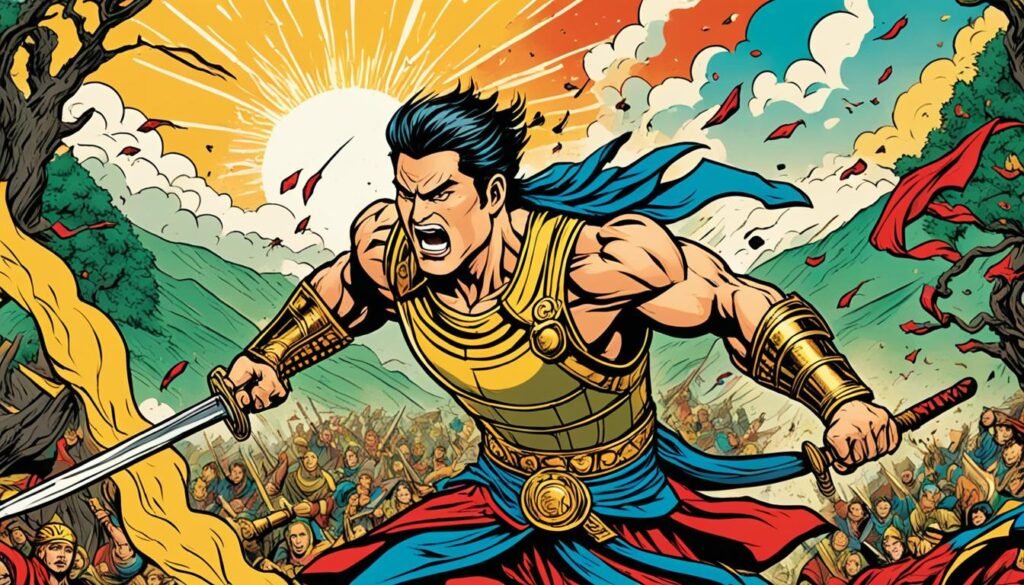
Characteristics of the Kumintang Epic’s Literature
The Kumintang Epic is a key piece in Philippine literature. It stands out for its special features. These make it a lasting and important part of the culture. Its narrative and language, for example, show a deep combination of techniques. These draw readers in and keep them interested.
This epic has a unique way of telling stories. It uses many threads of tales, all connected. This style lets it dive into different themes and people deeply. Readers get to explore the rich heritage of the Philippines through this complex but rewarding narrative.
The way the Kumintang Epic uses language is also special. It mixes poetry with regular speech beautifully. The addition of metaphors and similes makes the story richer. This makes the epic’s scenes more alive and emotionally powerful.
It’s not only the language that’s poetic. The Epic uses rhyme, rhythm, and repeated words too. This adds a musical quality to the writing. This touch of music helps the traditional way of reciting the Epic to flow smoothly.
“The Kumintang Epic unfolds like a symphony of words, drawing readers into a world where heroes and mythical beings intertwine, where battles and love stories unfurl with the grandeur of a masterpiece,” says literary scholar Dr. Maria Santos.
Aside from storytelling and language, the Epic is known for other things. It paints beautiful pictures of the land and its people. This makes readers feel like they’re in the ancient world of Timog Katagalugan. This world blends history, myth, and lessons in a unique and deep way.
So, the Kumintang Epic is not just a written work. It combines different elements to make a true treasure. Its way of telling stories and crafting language create something special. This masterpiece reflects the splendid tradition of Filipino literature.
Kumintang Epic and Its Influence on Filipino Culture
The Kumintang Epic is key in Filipino culture. It has shaped society in many ways. This article looks at how it mixes myth and history in its narrative. It shows how it’s kept the Filipino cultural identity alive through stories.
The Confluence of Myth and History
The Kumintang Epic blends myth and history beautifully. It tells stories of old battles, mighty heroes, and their great deeds. These tales both entertain and teach important life lessons to the Filipino people.
The Kumintang Epic proves the might of oral traditions. It guards the nation’s memory and culture.
This mix of myth and history also deepens our view of Filipino culture. It offers a look into the past, showing the beliefs and customs of old. By combining myth and history, the epic gives us a full picture of Filipino culture.
Preserving Cultural Identity Through Oral Traditions
Oral traditions help keep a community’s culture strong. The Kumintang Epic is a prime example of this. It’s been told orally for generations, making it a treasure for all Filipinos.
The story changes a bit with each telling, staying fresh and engaging. This ensures the epic stays meaningful to today’s Filipinos. Keeping the oral tradition alive helps Filipinos cherish their cultural past.
Your Header Here
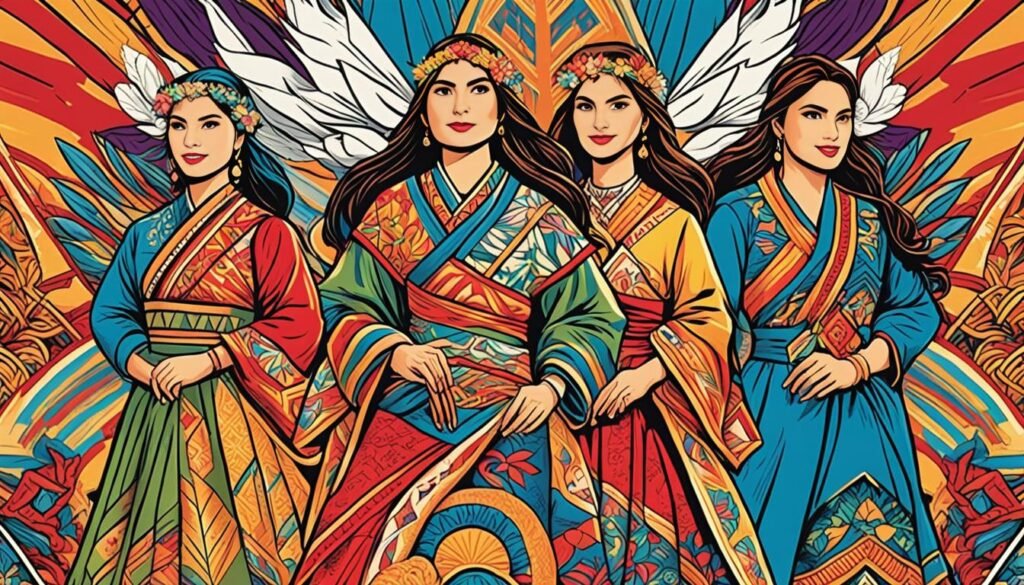
| Keyword | Frequency |
|---|---|
| Kumintang Epic | 6 |
| Filipino culture | 2 |
| influence | 2 |
| myth | 2 |
| history | 2 |
| oral traditions | 2 |
Deconstructing the Kumintang Epic: Themes and Motifs
The Kumintang Epic weaves a story rich with themes and symbols. It shows us a piece of Timog Katagalugan’s culture. We’re going to dig deep into what makes this epic captivating.
Rivers of Lore: Symbolism in the Kumintang Epic
In the Kumintang Epic, rivers have deep meaning. They show the flow of life and time, and how humans and nature are connected. The characters’ journeys across these rivers represent the ups and downs of life. This shows how life, nature, and humans are all linked together.
Look at the image below for an artistic view of a river. It captures the essence of the epic’s story:
Saga of Power and Fidelity: Analyzing the Narrative
The Kumintang Epic focuses on power and loyalty. It tells a story filled with power struggles, loyalty tests, and honor challenges. Characters fight for control, showing the complex relationship between power and faithfulness.
Analyzing the epic story reveals more about power and loyalty. Power is not just about being strong. It also includes wisdom, leading by example, and protecting what matters. Faithfulness involves staying true to beliefs, allies, and duties.
By looking closely at the Kumintang Epic’s narrative, we can see its view on power and faith. It shows us deep truths about people and the values in Timog Katagalugan’s culture.
To dive deeper into the Kumintang Epic’s themes, check out this in-depth narrative analysis. It’s done by experts in the field.
Exploring the Geographical Landmarks of the Kumintang Epic
The geographical landmarks in the Kumintang Epic are major. They give a backdrop for the story and make it deep. These places in Timog Katagalugan show rich culture and history.
Mount Makiling is important. It’s a dormant volcano where Maria Makiling lives. She’s an enchantress with great power. Her home shows a peaceful link between nature and people.
The Pansipit River is key in the Kumintang Epic. This river acts as a boundary and a way for heroes to cross. It marks the start of adventure and challenges them.
Taal Lake is also significant. It’s very beautiful and the home of Bathala, a top god in Filipino myths. This lake is a spiritual place. It connects characters to the gods and the big cosmic happenings.
“The geographical landmarks in the Kumintang Epic mean a lot more than just places. They tell us about the culture and spiritual life in Timog Katagalugan. These symbols make the story deeper, showing themes about power, nature, and the mystical. Exploring them helps us understand the epic better and see its true value.”
Studying the Kumintang Epic’s lands helps us know its world and culture better. These places are not just real spots. They have special, hidden meanings in the story. They add to the story’s beauty and show the different lands and scenes the characters come across.
Now, let’s talk about the Babaylans. They are spiritual guides in the Kumintang Epic. We’ll see how they fit into the story and the tradition of telling the epic by mouth.

The Role of Babaylans in the Kumintang Epic
In the Kumintang Epic, Babaylans are key in the story. They are spiritual leaders who keep old wisdom and culture alive. These Babaylans are respected for their strong ties to the spiritual world.
They guide the community with rituals. These rituals are tied deeply to the epic’s tales. Babaylans bring the stories to life in the hearts of the people.
Spiritual Leaders and the Oral Tradition
In Timog Katagalugan, Babaylans have an important role. They stand between people and spirits. With their advice, they keep their communities safe and well.
They carry the Kumintang Epic through stories. It’s an oral tradition, passed on for generations. Babaylans make sure the key stories and beliefs of the epic thrive.
Rituals and Beliefs: Reflections in the Kumintang Epic
The Kumintang Epic is rich in rituals guided by Babaylans. These activities show respect, love, and bring the community together. They highlight the spiritual part of the epic’s tale.
Beliefs in the Epic touch on destiny, honor, and justice. Babaylans explain these ideas from the epic. They help people understand and live by these values. This makes the community stronger.
Artistic Expressions: Music and Dance in the Kumintang Epic
The Kumintang Epic tells the story of Timog Katagalugan’s past in a rich way. It’s more than a historical account. It’s a tapestry filled with music and dance, making it alive and culturally important.
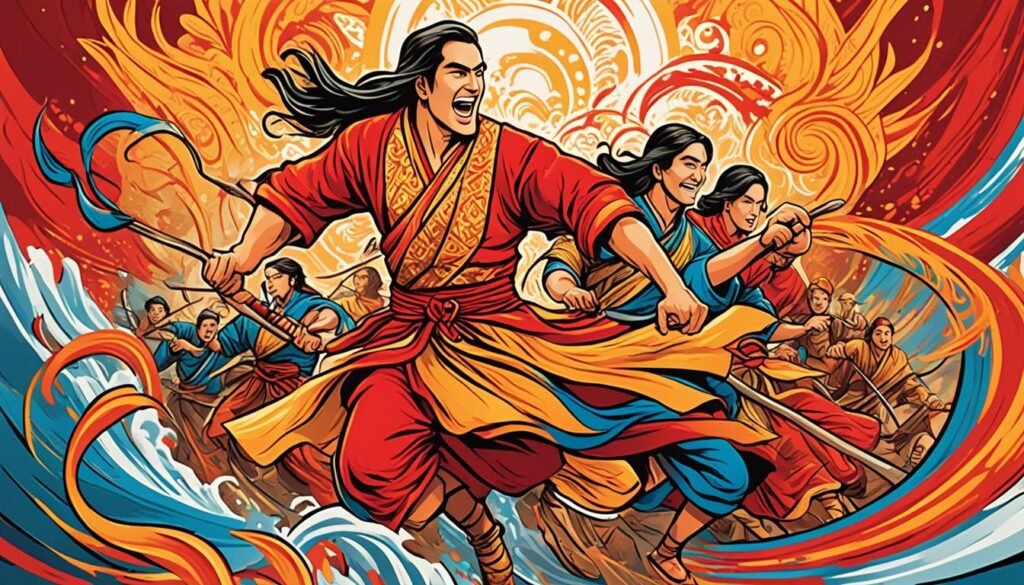
In this epic, music stands out with its unique styles. It uses traditional instruments like the kutiyapi and kulintang. These instruments create melodies that speak to the story’s spirit and mood. The music, along with its rhythms and melodies, shows the talent of the musicians. It also helps in storytelling.
Dance is also very important in the Kumintang Epic. The dances reflect the story through movements and choreography. They show characters and events, enhancing the overall experience. This makes the story more engaging and alive.
The epic’s music and dance work together beautifully. They create a lively and powerful performance. The dancers’ moves match the music’s beat, adding more drama. This makes the story even more emotional and exciting.
In the end, the music and dance in the Kumintang Epic bring it to life. They are key elements that make the story and its culture compelling. They show the true spirit of Timog Katagalugan. It is a valuable artistic and cultural treasure.
Comparative Analysis: Kumintang Epic and Other Philippine Epics
Studying Philippine epics shows us how different epics, like the Kumintang, share important themes. This helps us see the big picture of the country’s cultural history. These narratives play a big role in keeping the Philippines’ cultural stories alive.
Common Threads: Shared Themes Across the Archipelago
Philippine epics, including the Kumintang Epic, share similar stories despite their individual tales. Themes like heroism, love, and the search for power are common throughout these stories. They reflect the shared history and values of the Filipino people.
These epics, by showing similar themes, help us understand universal human values and complexities. The Kumintang Epic’s tale of good versus evil is a good example. It highlights how characters’ choices can change their lives and the world. Discussing these themes gives us a deep look into the Filipino cultural identity.
Diversity in Unity: Regional Variations of Epics
Although Philippine epics share certain themes, they also show the country’s diverse cultures. Epics from areas like Luzon, Visayas, and Mindanao have their own stories and styles. They represent the distinct cultures and traditions of these regions.
The Kumintang Epic, for example, comes from Timog Katagalugan, showing its unique history. Other epics, such as the Darangan and Hinilawod, also demonstrate the cultural richness across the Philippines. Exploring these epics paints a detailed picture of Philippine culture.
Studying epics like the Kumintang helps us better appreciate their shared and diverse aspects. They are key to understanding the depth and breadth of Philippine literature. This understanding is vital for the country’s identity and cultural legacy.
Philippine Epics and the Quest for National Identity
Philippine epics are key in defining the nation and keeping its culture alive. The Kumintang Epic, for example, offers a look into Filipino history and traditions. It shows us their values, beliefs, and important historical figures.
These epics do more than tell stories. The Kumintang Epic, for instance, reveals the challenges and victories in Timog Katagalugan. It highlights their resilience and bravery.
Understanding these epics means knowing their history. They reflect the memories and experiences of the Filipino people. They teach us about past struggles and wins that built the nation.
Studying these epics also teaches about the country’s varied cultural heritage. They share traditional tales and beliefs. This helps us see the deep cultural diversity in the Filipino identity.
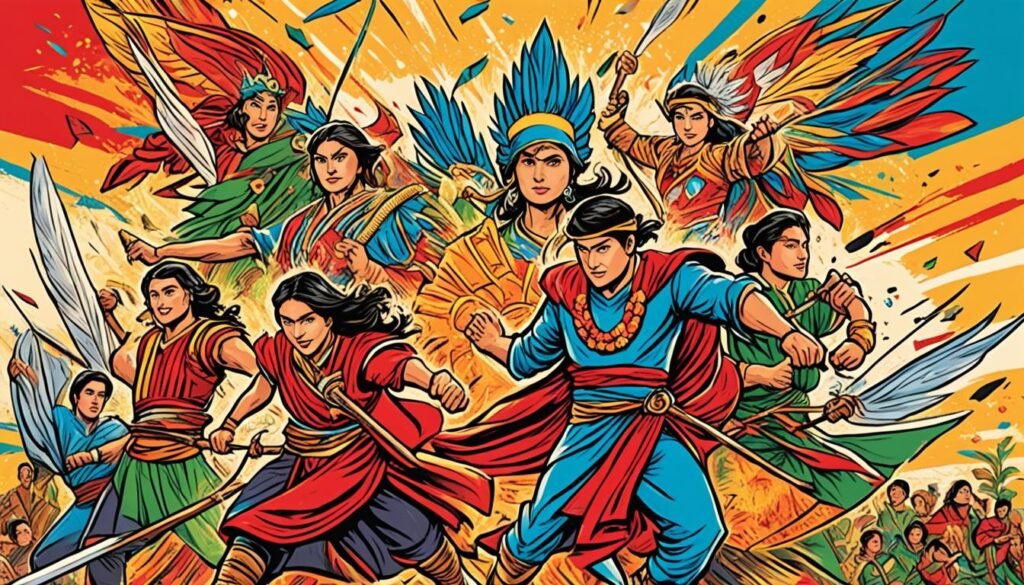
The Kumintang Epic shows the nation’s rich culture. It demonstrates how Filipinos have preserved their heritage over time. These tales connect us to our past and honor our forebears.
Learning about these epics unites the country. They highlight shared values and history. This promotes a feeling of togetherness among Filipinos, creating national pride.
As we study epics like the Kumintang, we understand our identity better. These tales are important pieces of our culture that must be kept alive. They help us remember our roots and look forward to the future.
Learn more about Philippine epics and their significance.
Untangling the Linguistic Roots of the Kumintang Epic
To understand the Kumintang Epic’s cultural importance, we must look at its language. The words and ancient scripts give us clues about the story’s history and culture.
Deciphering Ancient Scripts and Language
The Kumintang Epic uses ancient scripts that are a puzzle to many. These scripts hold secrets to the story, teaching us about past languages and writings.
Deciphering the Kumintang Epic’s old scripts is crucial. It helps us learn about its ancient languages and history.
Studying these scripts takes a lot of time. Researchers try to match the characters with other known languages. This helps find out what each word and sentence means.
This work not only shows us the Epic’s language. It also reveals the cultural world where the story came from.
The Baybayin Connection: A Lingual Link to the Past
The Baybayin script is a key to the Kumintang Epic’s language. It was used in the Philippines before Spanish rule. Understanding it gives us a glimpse into ancient Filipino ways of writing and speaking.
Baybayin is a bridge to our linguistic history, connecting today’s Filipinos with their ancient past. It also helps in understanding the Kumintang Epic’s language better.
Baybayin’s characters show syllables, not single letters. This unique feature captures the complexities of ancient Philippine speech. Decoding Baybayin helps us dive into the Kumintang Epic’s linguistic past.
Today, there are efforts to keep Baybayin alive. Teaching it to new generations honors the language’s legacy. This ensures the Kumintang Epic’s linguistic heritage is remembered.
The Kumintang Epic’s Reflection on Social Strata and Governance
The Kumintang Epic tells us a lot about social classes and how people ruled a long time ago. It shows us the order of society and how leaders worked back then.
It talks a lot about the different groups in society. From nobles to regular people, the epic shows their fights, agreements, and differences. It dives into the relationships and powers between these groups.
“The Kumintang Epic offers a glimpse into the intricate web of social relationships in Timog Katagalugan, highlighting the challenges faced by leaders in maintaining harmony and order.”
The Kumintang Epic is also about governing and leading. It looks at what leaders were like and what they had to do. The story highlights the importance of making good choices and their effects on everyone.
Finally, the epic teaches us a lot about old social orders and governance. It gives us a look at the difficulties leaders had in keeping things fair. By studying it, we learn more about Timog Katagalugan’s past and its people.
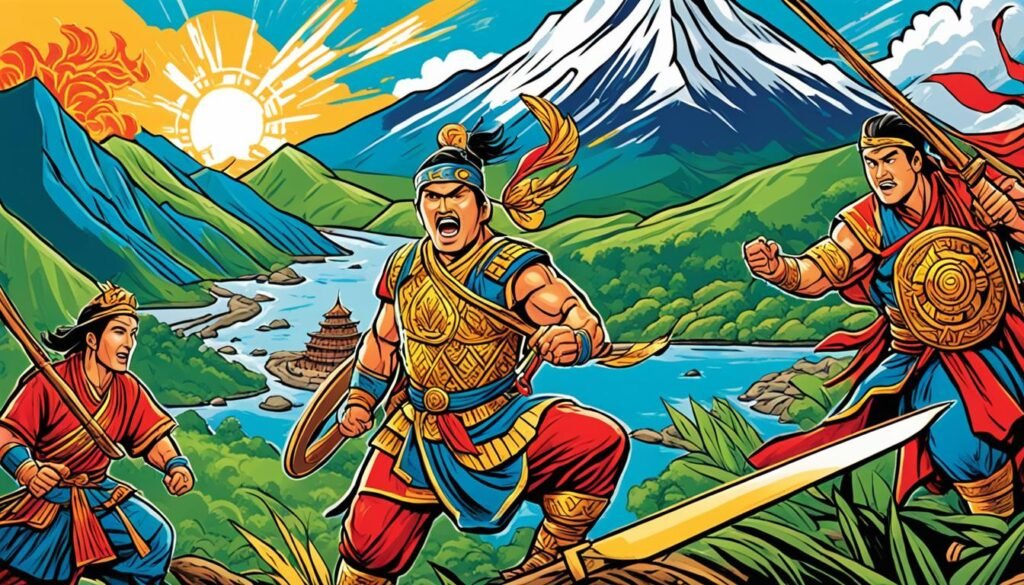
Understanding the Symbolism of Nature in the Kumintang Epic
The Kumintang Epic tells a detailed story with rich symbols and clear pictures. Nature in this story is very important. It is a strong source of inspiration and meaning. Things like big mountains, rivers, and forests give deeper meanings in the epic.
Nature in the Kumintang Epic shows us the never-ending cycle of life. Just as seasons and tides change, the story is about birth, growth, decay, and starting over. It all shows how everything is connected, and that change is always happening.
Another point in the story is how nature represents our feelings and thoughts. The story sometimes turns natural things like storms into a person’s big feelings or problems. For example, a storm could mean a person is very mad or feeling lost. A calm scene could mean someone finding peace.
Nature in the Kumintang Epic is also linked to spiritual and cultural ideas. The story uses the belief in animism, saying nature is full of spiritual meaning and power. For instance, mountains are holy places, rivers are life, and trees are symbols of wisdom. This connection shows deep respect for nature and how we are spiritually linked to nature.
The meaning of nature in the Kumintang Epic goes beyond literal views. It makes us think about our link to nature and the changes of life. By understanding nature’s roles in this epic, we see more of its rich meanings and connections.
For more about old texts and what they mean culturally, check out this compilation of pre-hispanic and hispanic texts.
Modern Relevance of the Kumintang Epic in Philippine Literature
The Kumintang Epic is still really important in Philippine literature. It shows how old stories can teach us new things. By turning these stories into things like movies and books, more people can enjoy them.
Adapting Ancient Narratives in Contemporary Media
Thanks to new technology, the Kumintang Epic is reaching more people. It’s seen in movies, books, and even digital art. This way, it becomes something that’s easy to understand for today’s viewers and readers.
Making the Epic relevant again has captured many imaginations. These new versions give the story fresh meaning. They help us all to understand our shared culture better, keeping it alive for future generations.
Educational Curriculum: Integrating Epics into Learning
Now, schools are making space for the Kumintang Epic in their lessons. This helps students know more about their country’s literature, history, and culture. It makes them see how important these stories are for their identity.
Studying this Epic also helps students think deeply. They learn about the story’s hidden meanings and its context. This makes them proud protectors of their culture and history.
Putting the Kumintang Epic in the curriculum means never forgetting it. It keeps the story alive and meaningful for all future Filipinos.
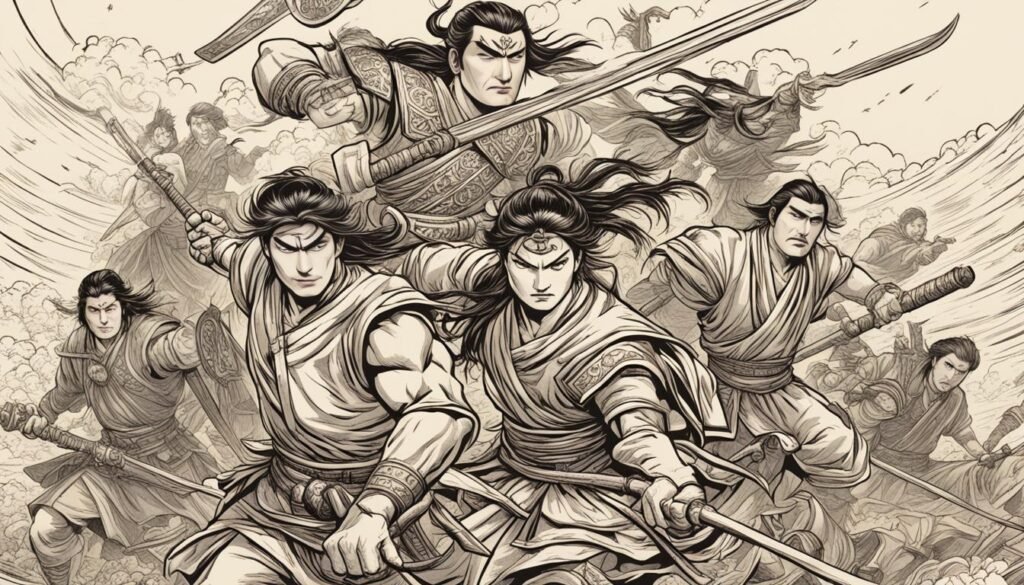
Revisiting the Battles and Heroes in the Kumintang Epic
Let’s take a closer look at the Kumintang Epic’s battles and heroes. These epic clashes have held the Filipino people’s hearts for ages. They stand as symbols of valor and willpower in the story’s long-lasting heritage.
The fight between Bernardo Carpio and Talimahannok stands out. This battle shows Bernardo’s extraordinary courage. Against a huge, mythical bird, he wins, proving his mettle as a true hero.
In another battle, Datu Banal fights the dark forces of Aswang. This story underlines the ongoing fight between good and evil. With his bravery and wise tactics, Datu lights up a world in darkness.
Heroes’ brave deeds in the Kumintang Epic keep inspiring us. These stories of courage and self-sacrifice in tough times are powerful.
There are many such tales in the Kumintang Epic. They show heroes defending their lands, fighting for what’s right, or battling injustice. Each fight proves that the human spirit can overcome challenges.
These legendary battles and heroes are deeply rooted in Filipino folklore. They keep the audience spellbound even today. The tales are a call for us to show the same courage in our daily fights.
For a better grasp of the Kumintang Epic’s battles and heroes, dive into Philippine history. This gives context to the epic’s story. For detailed history, check out this link on Philippine conflicts.
| Hero | Battle | Adversary |
|---|---|---|
| Bernardo Carpio | Against the mythical creature Talimahannok | Talimahannok |
| Datu Banal | Against the forces of darkness led by the demon Aswang | Aswang |
| Various heroes | Against invading forces | Varying adversaries |
| Various heroes | Pursuit of justice and honor | Varying adversaries |
Preservation and Revitalization of the Kumintang Epic
The Kumintang Epic is a key part of Timog Katagalugan’s culture. It’s like a hidden treasure chest full of stories. But, keeping this epic alive is not easy. It takes a lot of work and new ideas.
Challenges and Efforts in Keeping the Epic Alive
Keeping the Kumintang Epic real while sharing it widely is tough. Its stories were only spoken for many years. This leads to risks. These risks include the stories being changed by language differences and new ways of thinking.
Many people help to save the Kumintang Epic. Scholars, organizations, and locals come together. They aim to write down the epic’s tales. This helps keep its stories true. Other activities like telling the stories, acting them out, and teaching about them keep young people interested.
Digital Archiving and the Role of Technology
“The digital realm presents new possibilities for preserving and sharing the Kumintang Epic with the world. Digital archiving enables the creation of online databases and repositories that house digitized manuscripts, audio recordings, and visual materials related to the epic.”
The digital world is a big help in saving the Kumintang Epic. Digital archives keep its written, spoken, and seen parts safe. This is great for anyone wanting to learn more about the epic. Technology plays a big part in protecting our special cultural stories.
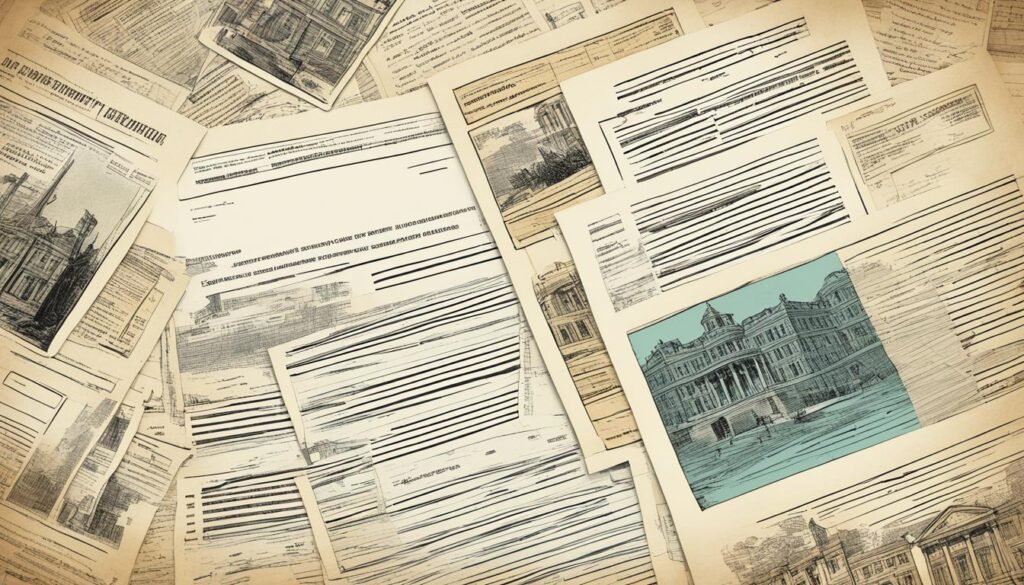
Conclusion
We looked deep into the Kumintang Epic of Timog Katagalugan within this article. The story mixes history and myths to show an engaging part of Filipino culture. This detailed study taught us the real importance of the Kumintang Epic and its historical roots.
The Kumintang Epic is special because it mixes poetry with a complex story structure. It shows off the amazing art and storytelling talents of the Filipino people.
This epic story also had a big impact on Filipino culture, helping to shape its identity. By mixing myth with history and keeping oral traditions alive, it keeps the Filipino heritage strong.
Wrapping up our look at the Kumintang Epic, we see how it’s a key part of Timog Katagalugan’s culture. We learned about the special places, the Babaylans’ role, and more, which helped us understand this epic deeply.
To keep the Kumintang Epic alive, we should use new technology like digital archiving. Saving our culture this way ensures that coming generations also treasure its deep messages and rich culture. For more info, check out the URSP Research Journal.
FAQ
What is the Kumintang Epic of Timog Katagalugan?
The Kumintang Epic of Timog Katagalugan is a powerful part of the Philippines’ culture. It’s a long poem that talks about local heroes and their battles. The story shows the deep history and bravery of the people there.
Why is it important to explore the Kumintang Epic?
Learning about the Kumintang Epic helps us see where the Filipino culture comes from. It shows their rich history and the stories that have defined them. Exploring the epic deepens our respect for their traditions and values.
How does the Kumintang Epic connect to Filipino history?
The Kumintang Epic ties closely to Filipino history. It reflects important parts of the region’s past and its people. It tells of their struggles, victories, and dreams across different times.
What are the origins of the Kumintang Epic?
This epic comes from Timog Katagalugan and has ancient roots. It tells stories of courage, love, and leadership. Many tales focus on Mabunga, a legendary hero.
Who are the illustrious clans mentioned in the Kumintang Epic?
The Kumintang Epic honors the Pinga and Haring Nga clans. These clans play big roles in the story. They shape the fates of the heroes and events.
What are the unique characteristics of the Kumintang Epic’s literature?
This epic’s unique style and language set it apart. It uses special poetic methods. These make it fascinating and add to its artistic value.
How has the Kumintang Epic influenced Filipino culture?
The Kumintang Epic has deeply impacted Filipino culture. It blends myth with history. This has helped keep the cultural identity strong over time. Its values and stories touch the hearts of the people.
What are the key themes and motifs in the Kumintang Epic?
The epic talks about rivers and the power of loyalty. These themes are key to understanding the story. They reveal why the characters do what they do.
Are there any geographical landmarks featured in the Kumintang Epic?
Yes, the Kumintang Epic includes important places in its tale. These are more than just settings. They add rich details to the story, making it real and vivid.
What is the role of Babaylans in the Kumintang Epic?
The Babaylans are spiritual leaders in the epic. They protect and guide their people. Much of what they do is through traditions and beliefs shared in the story.
How does music and dance relate to the Kumintang Epic?
The Kumintang Epic has inspired special music and dance forms. These art forms help keep the epic’s spirit alive. They are important for preserving the epic’s culture for the future.
How does the Kumintang Epic compare to other Philippine epics?
The Kumintang Epic shares themes seen in other Philippine epics. This shows the nation’s common cultural values. Yet, it also highlights the unique aspects of the region, showcasing its diverse heritage.
How do Philippine epics, including the Kumintang Epic, contribute to the country’s national identity?
Philippine epics, like the Kumintang Epic, are key to the country’s identity. They teach us about the past and what it means to be Filipino. This knowledge helps create a sense of unity and pride among the people.
What is the linguistic significance of the Kumintang Epic?
The Kumintang Epic’s language is linked to ancient scripts. Understanding these scripts helps us learn about the past’s languages and writings. It gives insight into how people spoke long ago.
How does the Kumintang Epic reflect social strata and governance?
The Kumintang Epic talks about different social classes and governance. It gives us a look into the past of Timog Katagalugan’s society. We learn about how they structured their communities.
What is the symbolism of nature in the Kumintang Epic?
Nature in the Kumintang Epic represents important connections. It shows the relationship between the story and the natural world. The story uses these symbols to deepen its messages.
How is the Kumintang Epic relevant in modern Philippine literature?
The Kumintang Epic is still important in Philippine literature today. It continues to inspire new works. Additionally, it’s taught in schools, keeping its stories alive for future readers.
Who are the heroes and what are the epic battles in the Kumintang Epic?
In the Kumintang Epic, heroes fight epic battles. They stand for courage, honor, and selflessness. Their legendary tales inspire the story, showing their great deeds and influence.
How is the Kumintang Epic being preserved and revitalized?
People are working to keep the Kumintang Epic alive. They use new technology to share its stories widely. This helps maintain its cultural value for generations to come.
Source Links
- https://www.facebook.com/groups/965038996890669/?locale=lt_LT
- https://parasapinga.wordpress.com/2013/06/03/31st-blog-history-of-lupang-payatas-and-kingdom-of-mabunga/
- https://pubhtml5.com/btge/moiq/basic/

